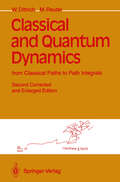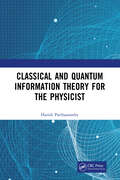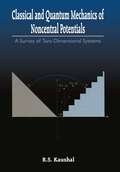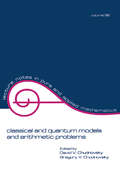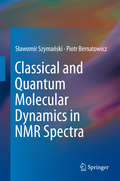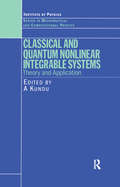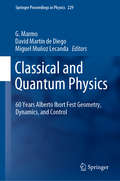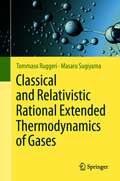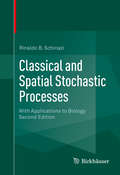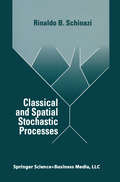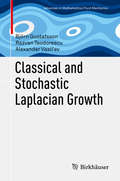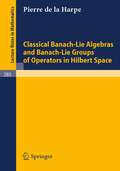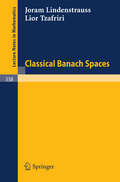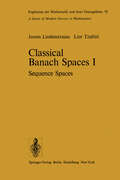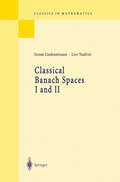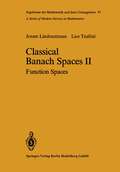- Table View
- List View
Classical and Quantum Cosmology (Graduate Texts in Physics)
by Gianluca CalcagniThis comprehensive textbook is devoted to classical and quantum cosmology, with particular emphasis on modern approaches to quantum gravity and string theory and on their observational imprint. It covers major challenges in theoretical physics such as the big bang and the cosmological constant problem. An extensive review of standard cosmology, the cosmic microwave background, inflation and dark energy sets the scene for the phenomenological application of all the main quantum-gravity and string-theory models of cosmology. Born of the author's teaching experience and commitment to bridging the gap between cosmologists and theoreticians working beyond the established laws of particle physics and general relativity, this is a unique text where quantum-gravity approaches and string theory are treated on an equal footing. As well as introducing cosmology to undergraduate and graduate students with its pedagogical presentation and the help of 45 solved exercises, this book, which includes an ambitious bibliography of about 3500 items, will serve as a valuable reference for lecturers and researchers.
Classical and Quantum Dynamics: From Classical Paths to Path Integrals (Graduate Texts in Physics)
by Walter Dittrich Martin ReuterGraduate students who wish to become familiar with advanced computational strategies in classical and quantum dynamics will find in this book both the fundamentals of a standard course and a detailed treatment of the time-dependent oscillator, Chern-Simons mechanics, the Maslov anomaly and the Berry phase, to name just a few topics. Well-chosen and detailed examples illustrate perturbation theory, canonical transformations and the action principle, and demonstrate the usage of path integrals.The fifth edition has been revised and enlarged to include chapters on quantum electrodynamics, in particular, Schwinger’s proper time method and the treatment of classical and quantum mechanics with Lie brackets and pseudocanonical transformations. It is shown that operator quantum electrodynamics can be equivalently described with c-numbers, as demonstrated by calculating the propagation function for an electron in a prescribed classical electromagnetic field.
Classical and Quantum Dynamics: From Classical Paths to Path Integrals (Graduate Texts in Physics)
by Walter Dittrich Martin ReuterGraduate students who want to become familiar with advanced computational strategies in classical and quantum dynamics will find here both the fundamentals of a standard course and a detailed treatment of the time-dependent oscillator, Chern-Simons mechanics, the Maslov anomaly and the Berry phase, to name a few. Well-chosen and detailed examples illustrate the perturbation theory, canonical transformations, the action principle and demonstrate the usage of path integrals. This new edition has been revised and enlarged with chapters on quantum electrodynamics, high energy physics, Green’s functions and strong interaction."This book is a brilliant exposition of dynamical systems covering the essential aspects and written in an elegant manner. The book is written in modern language of mathematics and will ideally cater to the requirements of graduate and first year Ph.D. students...a wonderful introduction to any student who wants to do research in any branch of theoretical Physics." (Indian Journal of Physics)
Classical and Quantum Dynamics: From Classical Paths to Path Integrals (Graduate Texts In Physics Ser.)
by Walter Dittrich Martin ReuterGraduate students seeking to become familiar with advanced computational strategies in classical and quantum dynamics will find in this book both the fundamentals of a standard course and a detailed treatment of the time-dependent oscillator, Chern-Simons mechanics, the Maslov anomaly and the Berry phase, to name just a few topics. Well-chosen and detailed examples illustrate perturbation theory, canonical transformations and the action principle, and demonstrate the usage of path integrals. The sixth edition has been enlarged to include the Heisenberg-Euler Lagrangian, Schwinger’s source theory treatment of the low-energy π-ρ-N physics and general relativity, where Riemann’s (Einstein’s) ideas on space and time and their philosophical implications are discussed.
Classical and Quantum Dynamics: from Classical Paths to Path Integrals
by Walter Dittrich Martin ReuterIn the past 10 to 15 years, the quantum leap in understanding of nonlinear dynamics has radically changed the frame of reference of physicists contemplating such systems. This book treats classical and quantum mechanics using an approach as introduced by nonlinear Hamiltonian dynamics and path integral methods. It is written for graduate students who want to become familiar with the more advancedcomputational strategies in classical and quantum dynamics. Therefore, worked examples comprise a large part of the text. While the first half of the book lays the groundwork for a standard course, the second half, with its detailed treatment of the time-dependent oscillator, classical and quantum Chern-Simons mechanics, the Maslov anomaly and the Berry phase, willacquaint the reader with modern topological methods that have not as yet found their way into the textbook literature.
Classical and Quantum Dynamics: from Classical Paths to Path Integrals
by Walter Dittrich Martin ReuterGraduate students wishing to become familiar with advanced computational strategies in classical and quantum dynamics will find in the one source both the fundamentals of a standard course as well as a detailed treatment of the time-dependent oscillator, Chern-Simons mechanics, the Maslov anomaly and the Berry phase, illustrated by many worked examples throughout the text. This second edition has been enlarged with a new chapter on topological phases in planar electrodynamics, and a discussion of the Aharonov-Bohm effect.
Classical and Quantum Information
by Dan C. MarinescuA new discipline, Quantum Information Science, has emerged in the last two decades of the twentieth century at the intersection of Physics, Mathematics, and Computer Science. Quantum Information Processing is an application of Quantum Information Science which covers the transformation, storage, and transmission of quantum information; it represents a revolutionary approach to information processing. Classical and Quantum Information covers topics in quantum computing, quantum information theory, and quantum error correction, three important areas of quantum information processing. Quantum information theory and quantum error correction build on the scope, concepts, methodology, and techniques developed in the context of their close relatives, classical information theory and classical error correcting codes. Presents recent results in quantum computing, quantum information theory, and quantum error correcting codesCovers both classical and quantum information theory and error correcting codesThe last chapter of the book covers physical implementation of quantum information processing devicesCovers the mathematical formalism and the concepts in Quantum Mechanics critical for understanding the properties and the transformations of quantum information
Classical and Quantum Information Theory for the Physicist
by Harish ParthasarathyThis book deals with certain important problems in Classical and Quantum Information Theory Quantum Information Theory, A Selection of Matrix Inequalities Stochastic Filtering Theory Applied to Electromagnetic Fields and Strings Wigner-distributions in Quantum Mechanics Quantization of Classical Field Theories Statistical Signal Processing Quantum Field Theory, Quantum Statistics, Gravity, Stochastic Fields and Information Problems in Information Theory It will be very helpful for students of Undergraduate and Postgraduate Courses in Electronics, Communication and Signal Processing. Print edition not for sale in South Asia (India, Sri Lanka, Nepal, Bangladesh, Pakistan or Bhutan).
Classical and Quantum Information Theory for the Physicist
by Harish ParthasarathyThis book deals with certain important problems in Classical and Quantum Information Theory Quantum Information Theory, A Selection of Matrix Inequalities Stochastic Filtering Theory Applied to Electromagnetic Fields and Strings Wigner-distributions in Quantum Mechanics Quantization of Classical Field Theories Statistical Signal Processing Quantum Field Theory, Quantum Statistics, Gravity, Stochastic Fields and Information Problems in Information Theory It will be very helpful for students of Undergraduate and Postgraduate Courses in Electronics, Communication and Signal Processing. Print edition not for sale in South Asia (India, Sri Lanka, Nepal, Bangladesh, Pakistan or Bhutan).
Classical and Quantum Mechanics of Noncentral Potentials: A Survey of Two-Dimensional Systems
by Radhey S. KaushalNon-central forces have a wide variety of applications in classical and quantum mechanics as demonstrated in this book. The author emphasizes the study of time-dependent potentials, predominantly in two dimensions, without neglecting the quite well understood time-independent case. The construction of invariants in the classical case and the study of solutions to Schrödinger's equation, as well as a detailed presentation of various mathematical techniques are of main concern to the author. The book addresses theoretical physicists and mathematicians, but it will also be useful for electrical and mechanical engineers.
Classical and Quantum Models and Arithmetic Problems
by ChudnovskyHere is an unsurpassed resource-important accounts of a variety of dynamic systems topicsrelated to number theory. Twelve distinguished mathematicians present a rare complete analyticsolution of a geodesic quantum problem on a negatively curved surface ... and explicitdetermination of modular function growth near a real point .. . applications of number theoryto dynamical systems and applications of mathematical physics to number theory . ..tributes to the often-unheralded pioneers in the field ... an examination of completely integrableand exactly solvable physical models .. . and much more!Classical and Quantum Models and Arithmetic Problems is certainly a major source of information,advancing the studies of number theorists, algebraists, and mathematical physicistsinterested in complex mathematical properties of quantum field theory, statistical mechanics,and dynamic systems. Moreover, the volume is a superior source of supplementary readingfor graduate-level courses in dynamic systems and application of number theory .
Classical and Quantum Models and Arithmetic Problems
by ChudnovskyHere is an unsurpassed resource-important accounts of a variety of dynamic systems topicsrelated to number theory. Twelve distinguished mathematicians present a rare complete analyticsolution of a geodesic quantum problem on a negatively curved surface ... and explicitdetermination of modular function growth near a real point .. . applications of number theoryto dynamical systems and applications of mathematical physics to number theory . ..tributes to the often-unheralded pioneers in the field ... an examination of completely integrableand exactly solvable physical models .. . and much more!Classical and Quantum Models and Arithmetic Problems is certainly a major source of information,advancing the studies of number theorists, algebraists, and mathematical physicistsinterested in complex mathematical properties of quantum field theory, statistical mechanics,and dynamic systems. Moreover, the volume is a superior source of supplementary readingfor graduate-level courses in dynamic systems and application of number theory .
Classical and Quantum Molecular Dynamics in NMR Spectra
by Piotr Bernatowicz Sławomir SzymańskiThe book provides a detailed account of how condensed-phase molecular dynamics are reflected in the line shapes of NMR spectra. The theories establishing connections between random, time-dependent molecular processes and lineshape effects are exposed in depth. Special emphasis is placed on the theoretical aspects, involving in particular intermolecular processes in solution, and molecular symmetry issues. The Liouville super-operator formalism is briefly introduced and used wherever it is beneficial for the transparency of presentation. The proposed formal descriptions of the discussed problems are sufficiently detailed to be implemented on a computer. Practical applications of the theory in solid- and liquid-phase studies are illustrated with appropriate experimental examples, exposing the potential of the lineshape method in elucidating molecular dynamics NMR-observable molecular phenomena where quantization of the spatial nuclear degrees of freedom is crucial are addressed in the last part of the book. As an introduction to this exciting research field, selected aspects of the quantum mechanics of isolated systems undergoing rotational tunnelling are reviewed, together with some basic information about quantum systems interacting with their condensed environment. The quantum theory of rate processes evidenced in the NMR lineshapes of molecular rotors is presented, and illustrated with appropriate experimental examples from both solid- and liquid-phase spectra. In this context, the everlasting problem of the quantum-to-classical transition is discussed at a quantitative level. The book will be suitable for graduate students and new and practising researchers using NMR techniques.
Classical and Quantum Nonlinear Integrable Systems: Theory and Application
by A KunduCovering both classical and quantum models, nonlinear integrable systems are of considerable theoretical and practical interest, with applications over a wide range of topics, including water waves, pin models, nonlinear optics, correlated electron systems, plasma physics, and reaction-diffusion processes. Comprising one part on classical theories
Classical and Quantum Nonlinear Integrable Systems: Theory and Application
by A. KunduCovering both classical and quantum models, nonlinear integrable systems are of considerable theoretical and practical interest, with applications over a wide range of topics, including water waves, pin models, nonlinear optics, correlated electron systems, plasma physics, and reaction-diffusion processes. Comprising one part on classical theories
Classical and Quantum Physics: 60 Years Alberto Ibort Fest Geometry, Dynamics, and Control (Springer Proceedings in Physics #229)
by G. Marmo David Martín de Diego Miguel Muñoz LecandaThis proceedings is based on the interdisciplinary workshop held in Madrid, 5-9 March 2018, dedicated to Alberto Ibort on his 60th birthday. Alberto has great and significantly contributed to many fields of mathematics and physics, always with highly original and innovative ideas.Most of Albertos’s scientific activity has been motivated by geometric ideas, concepts and tools that are deeply related to the framework of classical dynamics and quantum mechanics.Let us mention some of the fields of expertise of Alberto Ibort:Geometric Mechanics; Constrained Systems; Variational Principles; Multisymplectic structures for field theories; Super manifolds; Inverse problem for Bosonic and Fermionic systems; Quantum Groups, Integrable systems, BRST Symmetries; Implicit differential equations; Yang-Mills Theories; BiHamiltonian Systems; Topology Change and Quantum Boundary Conditions; Classical and Quantum Control; Orthogonal Polynomials; Quantum Field Theory and Noncommutative Spaces; Classical and Quantum Tomography; Quantum Mechanics on phase space; Wigner-Weyl formalism; Lie-Jordan Algebras, Classical and Quantum; Quantum-to-Classical transition; Contraction of Associative Algebras; contact geometry, among many others.In each contribution, one may find not only technical novelties but also completely new way of looking at the considered problems. Even an experienced reader, reading Alberto's contributions on his field of expertise, will find new perspectives on the considered topic.His enthusiasm is happily contagious, for this reason he has had, and still has, very bright students wishing to elaborate their PhD thesis under his guidance.What is more impressive, is the broad list of rather different topics on which he has contributed.
Classical and Relativistic Rational Extended Thermodynamics of Gases
by Tommaso Ruggeri Masaru SugiyamaRational extended thermodynamics (RET) is the theory that is applicable to nonequilibrium phenomena out of local equilibrium. It is expressed by the hyperbolic system of field equations with local constitutive equations and is strictly related to the kinetic theory with the closure method of the hierarchies of moment equations. The book intends to present, in a systematic way, new results obtained by RET of gases in both classical and relativistic cases, and it is a natural continuation of the book "Rational Extended Thermodynamics beyond the Monatomic Gas" by the same authors published in 2015. However, this book addresses much wider topics than those of the previous book. Its contents are as follows: RET of rarefied monatomic gases and of polyatomic gases; a simplified RET theory with 6 fields being valid far from equilibrium; RET where both molecular rotational and vibrational modes exist; mixture of gases with multi-temperature. The theory is applied to several typical topics (sound waves, shock waves, etc.) and is compared with experimental data. From a mathematical point of view, RET can be regarded as a theory of hyperbolic symmetric systems, of which it is possible to conduct a qualitative analysis. The book represents a valuable resource for applied mathematicians, physicists, and engineers, offering powerful models for many potential applications such as reentering satellites into the atmosphere, semiconductors, and nanoscale phenomena.
Classical and Spatial Stochastic Processes: With Applications to Biology
by Rinaldo B. SchinaziThe revised and expanded edition of this textbook presents the concepts and applications of random processes with the same illuminating simplicity as its first edition, but with the notable addition of substantial modern material on biological modeling. While still treating many important problems in fields such as engineering and mathematical physics, the book also focuses on the highly relevant topics of cancerous mutations, influenza evolution, drug resistance, and immune response. The models used elegantly apply various classical stochastic models presented earlier in the text, and exercises are included throughout to reinforce essential concepts.The second edition of Classical and Spatial Stochastic Processes is suitable as a textbook for courses in stochastic processes at the advanced-undergraduate and graduate levels, or as a self-study resource for researchers and practitioners in mathematics, engineering, physics, and mathematical biology.Reviews of the first edition:An appetizing textbook for a first course in stochastic processes. It guides the reader in a very clever manner from classical ideas to some of the most interesting modern results. … All essential facts are presented with clear proofs, illustrated by beautiful examples. … The book is well organized, has informative chapter summaries, and presents interesting exercises. The clear proofs are concentrated at the ends of the chapters making it easy to find the results. The style is a good balance of mathematical rigorosity and user-friendly explanation. —Biometric JournalThis small book is well-written and well-organized. ... Only simple results are treated ... but at the same time many ideas needed for more complicated cases are hidden and in fact very close. The second part is a really elementary introduction to the area of spatial processes. ... All sections are easily readable and it is rather tentative for the reviewer to learn them more deeply by organizing a course based on this book. The reader can be really surprised seeing how simple the lectures on these complicated topics can be. At the same time such important questions as phase transitions and their properties for some models and the estimates for certain critical values are discussed rigorously. ... This is indeed a first course on stochastic processes and also a masterful introduction to some modern chapters of the theory. —Zentralblatt Math
Classical and Spatial Stochastic Processes
by Rinaldo B. SchinaziThis book is intended as a text for a first course in stochastic processes at the upper undergraduate or graduate levels, assuming only that the reader has had a serious calculus course-advanced calculus would even be better-as well as a first course in probability (without measure theory). In guiding the student from the simplest classical models to some of the spatial models, currently the object of considerable research, the text is aimed at a broad audience of students in biology, engineering, mathematics, and physics. The first two chapters deal with discrete Markov chains-recurrence and tran sience, random walks, birth and death chains, ruin problem and branching pro cesses-and their stationary distributions. These classical topics are treated with a modem twist: in particular, the coupling technique is introduced in the first chap ter and is used throughout. The third chapter deals with continuous time Markov chains-Poisson process, queues, birth and death chains, stationary distributions. The second half of the book treats spatial processes. This is the main difference between this work and the many others on stochastic processes. Spatial stochas tic processes are (rightly) known as being difficult to analyze. The few existing books on the subject are technically challenging and intended for a mathemat ically sophisticated reader. We picked several interesting models-percolation, cellular automata, branching random walks, contact process on a tree-and con centrated on those properties that can be analyzed using elementary methods.
Classical and Stochastic Laplacian Growth (Advances in Mathematical Fluid Mechanics)
by Björn Gustafsson Razvan Teodorescu Alexander Vasil’evThis monograph covers a multitude of concepts, results, and research topics originating from a classical moving-boundary problem in two dimensions (idealized Hele-Shaw flows, or classical Laplacian growth), which has strong connections to many exciting modern developments in mathematics and theoretical physics. Of particular interest are the relations between Laplacian growth and the infinite-size limit of ensembles of random matrices with complex eigenvalues; integrable hierarchies of differential equations and their spectral curves; classical and stochastic Löwner evolution and critical phenomena in two-dimensional statistical models; weak solutions of hyperbolic partial differential equations of singular-perturbation type; and resolution of singularities for compact Riemann surfaces with anti-holomorphic involution. The book also provides an abundance of exact classical solutions, many explicit examples of dynamics by conformal mapping as well as a solid foundation of potential theory. An extensive bibliography covering over twelve decades of results and an introduction rich in historical and biographical details complement the eight main chapters of this monograph. Given its systematic and consistent notation and background results, this book provides a self-contained resource. It is accessible to a wide readership, from beginner graduate students to researchers from various fields in natural sciences and mathematics.
Classical Banach-Lie Algebras and Banach-Lie Groups of Operators in Hilbert Space (Lecture Notes in Mathematics #285)
by P. de HarpeClassical Banach Spaces (Lecture Notes in Mathematics #338)
by Joram Lindenstrauss Lior TzafririSpringer-Verlag began publishing books in higher mathematics in 1920, when the series Grundlehren der mathematischen Wissenschaften, initially conceived as a series of advanced textbooks, was founded by Richard Courant. A few years later a new series Ergebnisse der Mathematik und ihrer Grenzgebiete, survey reports of recent mathematical research, was added.Of over 400 books published in these series, many have become recognized classics and remain standard references for their subject. Springer is reissuing a selected few of these highly successful books in a new, inexpensive sofcover edition to make them easily accessible to younger generations of students and researchers.
Classical Banach Spaces I: Sequence Spaces (Ergebnisse der Mathematik und ihrer Grenzgebiete. 2. Folge #92)
by J. Lindenstrauss L. TzafririThe appearance of Banach's book [8] in 1932 signified the beginning of a syste matic study of normed linear spaces, which have been the subject of continuous research ever since. In the sixties, and especially in the last decade, the research activity in this area grew considerably. As a result, Ban:ach space theory gained very much in depth as well as in scope: Most of its well known classical problems were solved, many interesting new directions were developed, and deep connections between Banach space theory and other areas of mathematics were established. The purpose of this book is to present the main results and current research directions in the geometry of Banach spaces, with an emphasis on the study of the structure of the classical Banach spaces, that is C(K) and Lip.) and related spaces. We did not attempt to write a comprehensive survey of Banach space theory, or even only of the theory of classical Banach spaces, since the amount of interesting results on the subject makes such a survey practically impossible.
Classical Banach Spaces I and II: Sequence Spaces and Function Spaces (Classics in Mathematics)
by Joram Lindenstrauss Lior TzafririSpringer-Verlag began publishing books in higher mathematics in 1920, when the seriesGrundlehren der mathematischen Wissenschaften, initially conceived as a series of advanced textbooks, was founded by Richard Courant. A few years later a new series Ergebnisse der Mathematik und ihrer Grenzgebiete, survey reports of recent mathematical research, was added.Of over 400 books published in these series, many have become recognized classics and remain standard references for their subject. Springer is reissuing a selected few of these highly successful books in a new, inexpensive sofcover edition to make them easily accessible to younger generations of students and researchers.Classical Banach Spaces I and II From the reviews: “...the book is written in the best tradition of the beautiful series in which it appears. The material it presents is hard to find in other books. For people working in the structure theory of Banach spaces it will be most valuable as a source of references and inspiration. For those who wish to learn the subject the book deserves a warm welcome too.” Medelingen van het Wiskundig Genootschap “…The geometry of Banach lattices is a rich, beautiful, … and rewarding subject. The proof is in the reading and perusing of the masterpiece.” Zentrablatt für Mathematik





